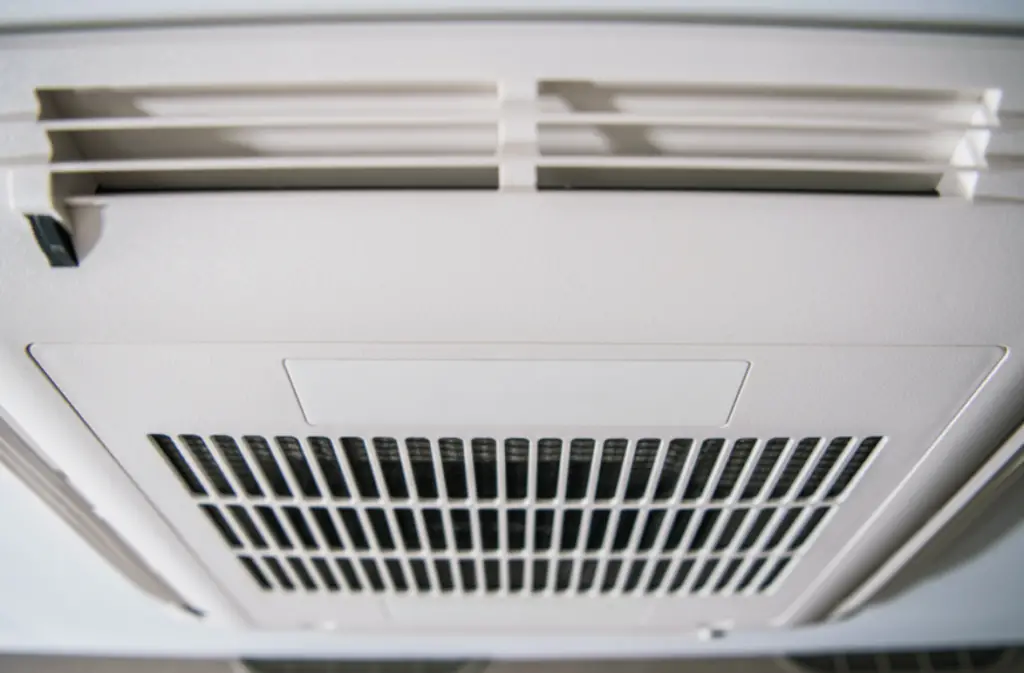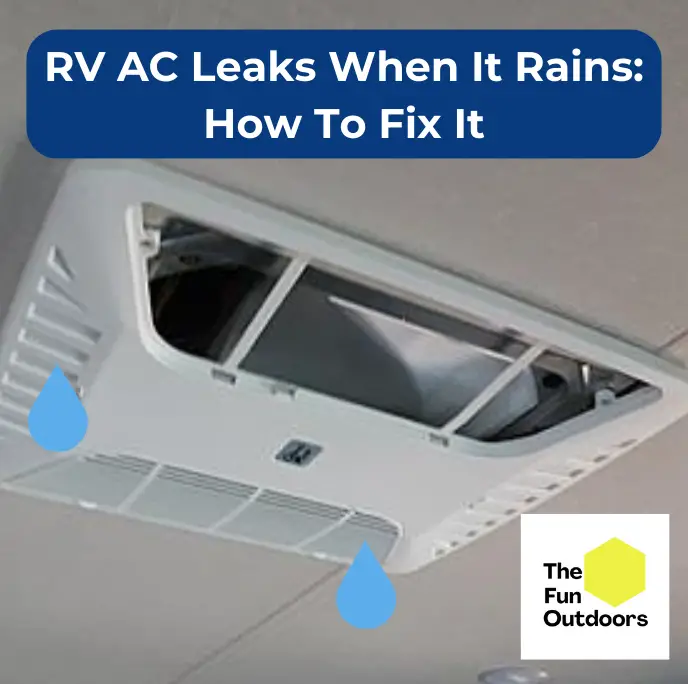RV air conditioners are a great way to keep cool during hot summer days on the road. But if your RV air conditioner leaks when it rains, it can cause water damage, mold, and other issues.
If you’re experiencing a leaky RV air conditioner, don’t worry – there are several things you can do to fix it and prevent it from happening again in the future, which is exactly what I’ll be covering in this guide.
Quick Facts:
- Loose or damaged mounting bolts and faulty gaskets are the most common causes of RV air conditioner leaks when it rains.
- Other culprits include damaged covers or vents, roof damage and debris, issues with caulking, condensation issues, and clogged or damaged drain pans.
- Identifying the cause of the leak and taking steps to fix it can prevent water damage and keep your RV air conditioner working properly.
RV Air Conditioner Leaks When It Rains? Top 7 Causes
As an experienced RV owner, I know how frustrating it can be when your RV air conditioner starts leaking water during a rainy camping trip.
To help you avoid this problem, I’ve compiled a list of the top 7 causes of RV air conditioner leaks when it rains.
Common RV AC Leak Issues: How To Diagnose and Fix Them
| Problem | Symptoms | Fixes |
| Loose mounting bolts | AC unit moves around on roof | Tighten mounting bolts |
| Damaged mounting gasket | Water seeping through gasket | Replace rubber gasket |
| Debris on roof | Water pooling around AC unit | Clean debris off roof |
| Clogged drain pan | Water dripping inside RV | Clear drain pan |
| Damaged caulking | Water seeping through cracks | Re-caulk around AC unit |
| Condensation buildup | Water dripping inside RV | Check evaporator coil and condensate drain line |
| Damaged cover | Water seeping through cracks | Replace cover |
Loose or Damaged Mounting Bolts
One of the most common causes of RV air conditioner leaks when it rains are loose or damaged mounting bolts.
If the bolts that are holding your air conditioner in place are loose or missing, water can leak into the areas around them.
As it then runs into the interior part of your AC unit, it’s going to find the most convenient hole to drip out and onto your RV floor.
If you’re experiencing leaks when it rains, it’s important to check the mounting bolts on your air conditioner.
If they’re loose, you’ll need to tighten them up. If they’re damaged, you’ll need to replace them.
Tightening Bolts and Replacing Gaskets
To tighten the bolts, turn off the air conditioner and unplug your RV from shore power or turn off the circuit breakers that supply juice to the A/C unit.
For RVs where the air conditioner controls are mounted on the A/C unit, you’ll likely find some plastic plugs around the outside edges of the housing.
Remove these plugs, and you’ll see the bolts that hold the unit in place. Use a socket wrench to tighten them up.
If the bolts are damaged, you’ll need to replace them. You can find replacement bolts at most hardware stores or RV supply stores.
Make sure the new bolts are the same size as the old ones.
Faulty Gaskets
If your RV air conditioner is leaking when it rains, one of the most common reasons could be a faulty gasket.
The gasket around your AC unit seals it to prevent leaks.
If it’s compressed too much or has become damaged, the condensation that’s created when your AC runs will have nowhere to go but outside your RV.
Replacing Gaskets
Replacing a gasket is a relatively simple fix that can be done by most RV owners with a little bit of know-how.
First, turn off your RV’s power supply and disconnect the AC unit from the roof.
Remove the shroud covering the AC unit and locate the gasket.
Carefully remove the old gasket and clean the area around it.
You can use a putty knife or scraper to remove any excess adhesive or debris.
Once the area is clean, you can install the new gasket.
Be sure to use a high-quality gasket that is specifically designed for your RV’s AC unit.
When installing the new gasket, be sure to apply a thin layer of adhesive around the edge of the AC unit to ensure a tight seal.
Once the gasket is in place, reattach the shroud and secure the AC unit back onto the roof of your RV.
Damaged Cover Or Vent Problems

One of the most common reasons for your RV AC leaking when it rains is a damaged cover or vent.
Here are some things to look out for and some tips on how to fix them:
Fixing Vent and Cover Issues
One of the first things to check when you notice a leak from your RV air conditioner is the cover or vent.
Over time, these can become damaged or loose, causing water to seep through and into your RV. Here are some steps to take to fix this issue:
- Check the bolts: Loose or damaged bolts can cause the cover or vent to become loose and allow water to enter. Make sure to tighten any loose bolts or replace any damaged ones.
- Inspect the mounting: The cover or vent should be securely mounted to the RV. If it is loose, it may need to be re-mounted or reinforced with additional screws or brackets.
- Replace damaged covers or vents: If the cover or vent is damaged beyond repair, it will need to be replaced. Make sure to choose a high-quality replacement that is designed for your specific RV model.
See Related: RV AC Dripping Water Inside: How To Fix It
Roof Damage and Debris
When it comes to RV air conditioner leaks, roof damage and debris are common culprits.
Over time, the sealant around the air conditioner unit on the roof can deteriorate, allowing water to seep through and enter your RV.
This can lead to leaks and potential water damage.
Addressing Roof Damage
To prevent leaks caused by roof damage, it’s important to inspect your RV roof regularly.
Look for any signs of wear or damage, such as cracks, holes, or tears. If you notice any issues, it’s important to address them as soon as possible.
One way to prevent roof damage is to avoid parking your RV under trees.
Falling branches and debris can cause damage to your RV roof, leading to leaks.
If you do park under trees, be sure to clean any debris off your roof regularly.
Another way to prevent roof damage is to avoid walking on your RV roof.
Even if you think your weight won’t cause damage, it’s best to avoid walking on the roof altogether.
This can help prevent cracks and other damage that can lead to leaks.
It’s very important to keep your RV roof clean and free of debris. This can help prevent clogs in your drainage system, which can lead to leaks.
Be sure to clean your RV roof regularly, and remove any debris that you find.
See Related: How Much Weight Can An RV Roof Hold
Issues with Caulking
Caulking is a sealant that is applied around the air conditioner to prevent water from seeping into the RV.
Over time, caulking can crack, shrink, or become damaged, which can allow water to enter the RV.
Re-Caulking
If you suspect that the caulking around your RV air conditioner is damaged, it’s important to address the issue as soon as possible.
Here are the steps I recommend for re-caulking your RV air conditioner:
- First, remove any old caulking using a caulk removal tool or a putty knife. Be careful not to damage the roof or the air conditioner while doing so.
- Clean the area thoroughly with a mixture of water and soap. This will remove any dirt or debris that could prevent the new caulking from adhering properly.
- Apply a new layer of caulking around the air conditioner. Be sure to use a high-quality sealant that is designed for use on RV roofs.
- Smooth out the caulking with a caulk smoothing tool or your finger. This will ensure that the sealant is evenly distributed and will provide a tight seal.
- Allow the caulking to dry completely before using your RV.
By re-caulking your RV air conditioner, you can prevent water from seeping into your RV and causing damage.
Plus, it’s a relatively easy and inexpensive fix that can save you a lot of headaches down the road.
Condensation Issues
Not all leaks are caused by a faulty unit or damaged roof. Sometimes, the culprit is simply condensation.
Dealing with Condensation
Condensation occurs when warm, moist air comes into contact with a cold surface, such as the evaporator coil in your air conditioning unit.
This can happen when the temperature inside your RV is significantly lower than the temperature outside, causing moisture to form on the coil.
To prevent condensation from causing leaks, make sure your RV is properly insulated and sealed.
You can also try increasing the temperature inside your RV to reduce the temperature differential between the inside and outside.
Another way to deal with condensation is to ensure that your condensate drain line is clear of any obstructions.
This line is responsible for removing excess moisture from your air conditioning unit, so if it becomes clogged, water can back up and cause leaks.
Regular maintenance is key to preventing condensation issues.
Make sure to clean your evaporator coil and condensate drain line regularly to ensure proper functioning of your air conditioning unit.
See Related: How To Fix An RV Air Conditioner Freeze Up
Clogged or Damaged Drain Pan
Another common reason why RV air conditioners leak when it rains is a clogged or damaged drain pan.
The drain pan is responsible for collecting and draining the condensation that builds up on the evaporator coil.
If the drain pan becomes clogged or damaged, it can cause water to overflow and leak into your RV.
Cleaning and Replacing Drain Pan
If you suspect that your RV air conditioner is leaking due to a clogged or damaged drain pan, there are a few steps you can take to fix the issue.
First, turn off your RV’s air conditioner and disconnect the power source.
Then, locate the drain pan underneath the evaporator coil.
You may need to remove the access panel to access the drain pan.
Next, check the drain pan for any debris or clogs.
If you see any debris or clogs, use a soft-bristled brush or compressed air to remove them.
Be careful not to damage the drain pan while cleaning it.
If the drain pan is damaged, you will need to replace it.
You can purchase a replacement drain pan from your RV dealer, an online supply house, or you can go looking for one at an RV salvage yard if the part you need is no longer being made.
Make sure to choose a drain pan that is compatible with your RV’s air conditioner.
Once you have cleaned or replaced the drain pan, turn on your RV’s air conditioner and check for any leaks.
If the issue persists, it may be a sign of a more serious problem and you should consult a professional.
Remember, regular maintenance and cleaning of your RV’s air conditioner can help prevent leaks and other issues.
So, make sure to keep your air conditioner in good condition to enjoy a comfortable and leak-free RV experience.
Check out our other helpful RV AC troubleshooting guides while you’re here:
How To Stay Cool In An RV Without Air Conditioning
RV AC Keeps Tripping Breaker: What To Do

